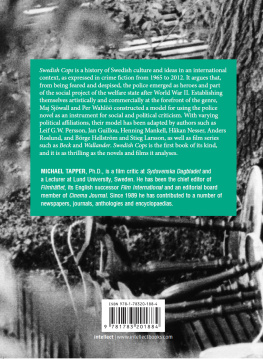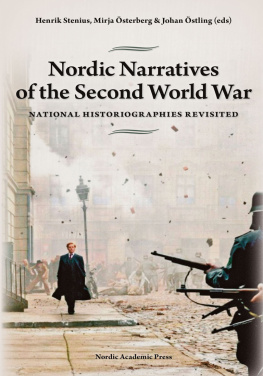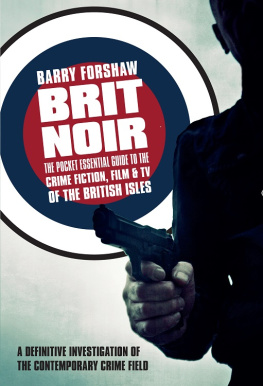
Encyclopedia of Nordic Crime Fiction
Works and Authors of Denmark, Finland, Iceland, Norway and Sweden Since 1967
Mitzi M. Brunsdale

McFarland & Company, Inc., Publishers
Jefferson, North Carolina
LIBRARY OF CONGRESS CATALOGUING DATA ARE AVAILABLE
BRITISH LIBRARY CATALOGUING DATA ARE AVAILABLE
e-ISBN: 978-1-4766-2277-4
2016 Mitzi M. Brunsdale. All rights reserved
No part of this book may be reproduced or transmitted in any form or by any means, electronic or mechanical, including photocopying or recording, or by any information storage and retrieval system, without permission in writing from the publisher.
Front cover images iStock/Thinkstock
McFarland & Company, Inc., Publishers
Box 611, Jefferson, North Carolina 28640
www.mcfarlandpub.com
In loving memory of Drake,
my constant companion through this work,
and my dear, dear friend.
Acknowledgments
My thanks to Dale Nelson for his appreciation of Nordic literature and his contributions of research materials; to Dr. Hiram Drache and Dr. Verlyn Anderson for their encouragement and suggestions; to Anne Jones, yet again for her blessedly sound sense; to Ann Zavoral for generously promoting the cause of Nordic crime literature; to my Fargo friends Monica and Betty and Judie, and Mecca Chapter, O.E.S., for their caring support; to my family for their understanding and help, especially Margaret and Norbert, and Jean and Maureen; and most of all, with love, to John, who provided me such an exquisite working environment for this large project.
Preface
As a long-time American book critic, several years ago I was struck by the scope, quality, and diversity of the crime fiction emerging since 1967 from the Nordic countriesSweden, Norway, Denmark, Iceland, and Finland. I also saw a pattern beginning to emerge, an ominous foreshadowing of totalitarianism reborn. The native Nordic populations are aging and leaving the labor market while immigration soars, encouraged by bureaucratic policies, often tainted by corruption, that have promoted substantial increases in immigration-related bureaucracy that until recently has seemed unable or unwilling to undertake effective integration programs. As a result, both skilled and unskilled adult asylum-seekers from the former Soviet bloc countries and the Moslem Third World and their children who grow up in the Nordic countries often do not successfully assimilate or join the work force. Taxes, crime rates, and racial tensions are adversely affecting the native Nordic populations, increasing the appeal of neoNazi groups, rapidly growing in political influence in the Nordic nations as well as across Europe. Because I believe Nordic crime fiction, which largely deals with the serious societal problems resulting from originally well-intentioned Nordic welfare state policies now proving problematic, has enormous relevance to todays dangerous world, I undertook this project to bring the magnitude and importance of Nordic crime literature to English-speaking readers.
At first I had little idea of the impressive amount of crime fiction involved and of the intricate historical-cultural relationships underlying it in each country, though professionally as a comparatist I have always been fascinated by the literature of the North. My first published scholarly article treated Ibsens Rosmersholm; my first national conference paper dealt with correspondences between Ibsens Vikings at Helgeland and Hedda Gabler and D.H. Lawrences use of the Northern myth of Brynhild; and I have written extensively on Sigrid Undset, Norways only female Nobel Prize winner, including a book-length literary biography, Sigrid Undset: Chronicler of Norway.
I am personally acquainted with Nordic culture, too. Though I have not one drop of Scandinavian blood, I have lived almost all of my life in eastern North Dakota, home to many descendants of the Norwegian newcomers who began arriving in the late 1800s. I know Icelandic descendants who boast that their women are the most beautiful in the world, because their ancient ancestors stole only the loveliest Irish women to bring home. Many Swedish descendents live in nearby Minnesota, where Finns celebrate St. Urhos Day and Danish smorgasbords and pastries abound. Just across the Red River from our Fargo home a new museum houses the Hjemkomst, a replica Viking longship that sailed to Norway a few years ago; my Labrador retriever came from Sweden; two of our daughters attended St. Olaf College in Northfield, Minnesota, and devoutly make lefse every winter; my husband is a six-foot-three spiritual son of the Vikings; and his fathers family taught me to bake sandbakkelse and Berliner kranser and krumkake (in Traill County called strul), like the treats provided every Syttende Mai (Norwegian Independence Day) in certain small-town banks, served by women wearing the authentic bunad and slje (dress and jewelry) of their forefathers Norwegian home regions. I draw the line at lutefisk, lye-soaked cod that a Swedish friend claimed forced her to leave Scandinavia.
All those colorful experiences, however, reflect the Scandinavia of old, not todays Nordic countries, whose serene surfaces often place them at the top of worlds happiest countries lists but conceal roiling swells of threatening social, economic, and political issues that animate the plots of their contemporary crime fiction. Todays torrent of Nordic crime novels, even in translation, with many being made into movies and television series, demonstrates the dramatic extent and significance of this literary phenomenon. I strongly believe Americans need to pay attention to these ill tidings from the North.
Introduction
You hold a mirror to crime to see whats happening in society.
Henning Mankell
We do not know enough, and we should know far more about Nordic crime fiction, which for a long time was dismissed in their home countries as popular entertainment not worthy of the attention that mainstream works received. Today the achievements of Nordic crime fiction authors deserve as much, if not more, attention as serious novels do, not only by native-speaker scholars but by general readers in translation, to ponder the profound social, political, economic, and cultural issues they present. Each Nordic countrys crime fiction is presented here separately, headed by an epigraph from its earliest literature: for Sweden, Norway, Denmark, and Iceland, the Hvaml; and for Finland, the Kalevala. Each countrys section contains an introductory essay placing the development of its crime fiction in its historical-cultural context; lists of that countrys major awards for crime fiction; a parallel chronology of the countrys major literary-cultural events and those of the world; an alphabetical listing of authors whose crime fiction mainly appears after 1967 with brief essays analyzing their major crime fiction; lists of selected works set in that country by non-native authors, where applicable; and a Works Cited listing. The 1967 publication in English translation of the first Sjwall-Wahl Martin Beck novel Rosanna marks the beginning of the contemporary explosion of Nordic noir fiction.
Today the term Nordic is used to indicate the five north European countries collectively, while Scandinavian generally refers to Norway, Sweden, and Denmark, and usually includes Iceland. Finlands Finno-Ugric language and the nations complicated historical relationship with Russia set it apart from its neighbors which share the Germanic roots of their languages and traditions. In the discussion below, however, Nordic and Scandinavian may be used interchangeably, especially in quoted material, as is still done in general non-professional usage.
Next page









